Current REgistered attendees 167 --- AS OF today!!! Registration is currently is closed
Feb 20, 1989 - Norton AFB 52nd Crew
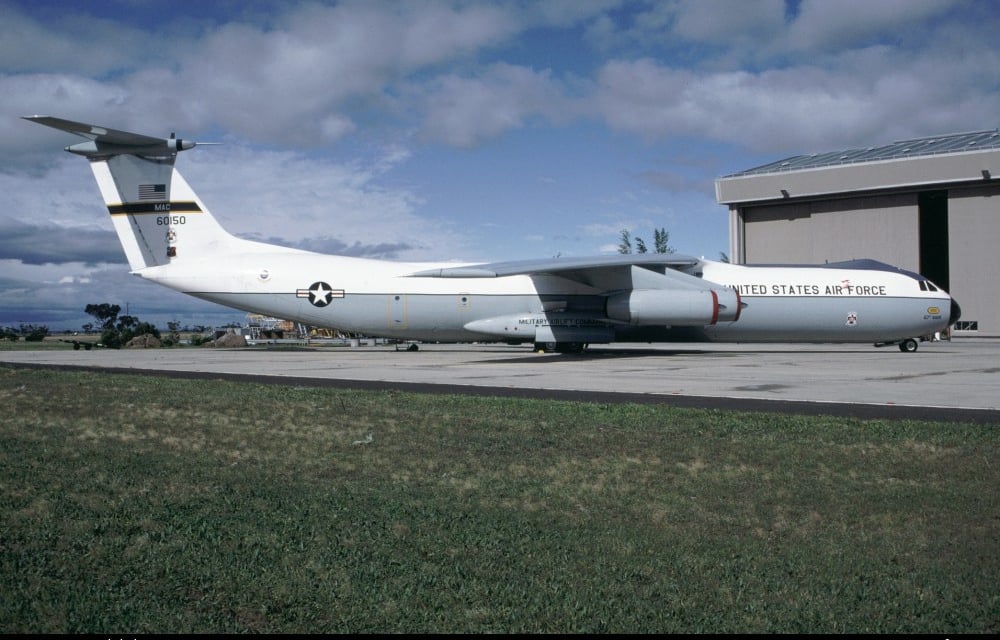

photo (c) via Werner Fischdick; Melbourne-Tullamarine Airport, VIC (MEL); October 1987
As a former crew member of the C-141, I have mixed feelings about sharing information regarding the incident involving 60-0150. I was originally scheduled for that mission but was removed at the last minute due to a conflict with my annual simulator training alongside loadmaster Roger, who also had to step down.
I recognize that many of you are still actively flying, though not everyone had the opportunity to be on a crewmember on the C-141. During my time in the Air Force, and likely still today, there was a strong belief that every accident or incident carries valuable lessons.
While our access to comprehensive details is often limited to unofficial sources, there are still insights to be gained. Despite the painful reality that lives were lost and affected, images often resonate more powerfully than words.
This is why we include photographs on our Norton reunion website; they are an integral part of our C-141 legacy at Norton, regardless of our feelings about them.
It would be ideal if our experiences with the C-141 were solely filled with joyful memories, but that is not the case. Those who served, and continue to serve, deserve to understand the complete narrative.
We invite anyone with knowledge of the incident, photos, crew's names to contact us, as we wish to honor their sacrifice by including their names here. Additionally, any relevant information regarding 600150 would be greatly appreciated.
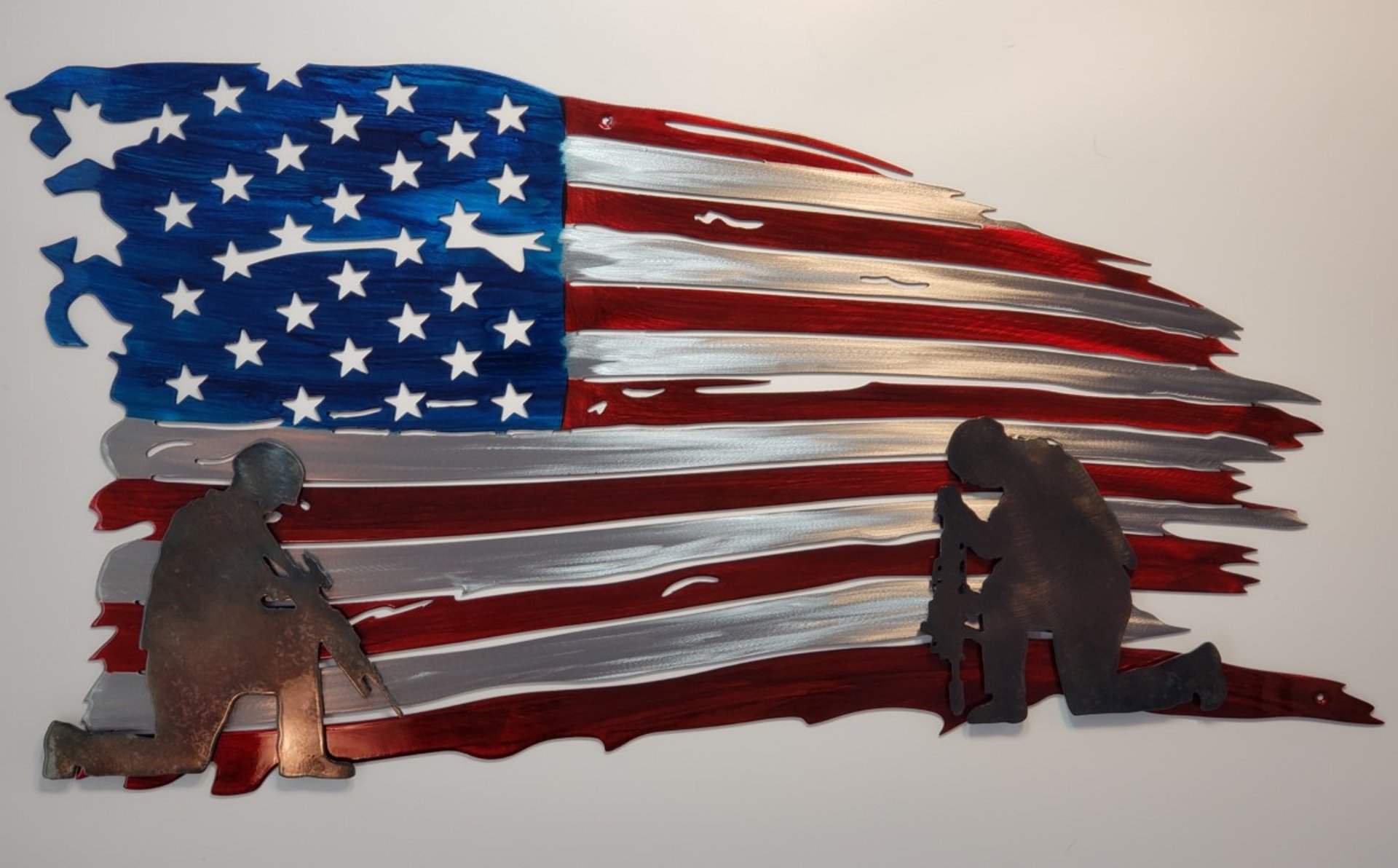
Aircrew
Pilot: Capt Mark J. Chambers P
Co-Pilot: Capt John F. Young P
FE: TSgt Ronald D. Grubbs IFE
FE: SSgt Karl M. Kohler Basic FE
FE: SSgt John W. Remerscheid 2nd FE
LM: MSgt Robert E. Wright Sr. LM
LM: A1C Scott D. Craig LM
Passenger: Unknw
Date: Monday 20 February 1989Time: 20:00
Narrative:
The C-141B departed Norton AFB for a flight to Hurlburt Field with an intermediate stop at Peterson Field. The crew had to return back to Norton due to a leaking comfort pallet at which time they elected to extend their crew duty day by 2 hours in order to make it into Hurlburt Airfield. At the end of the second leg, the crew were confronted with thunderstorms covering the approach path for the ILS approach to runway 36 at Hurlburt Field, the primary instrument runway.
The crew requested the TACAN approach to runway 18, which was an approach over swampy terrain. The aircraft entered a high rate of descent, causing the GPWS to sound. The copilot reset two GPWS warnings and the descent was continued below the Minimum Descent Altitude (MDA) of 345 ft agl. The airplane finally impacted terrain in a wings level, nose low attitude.
Sources:
C-141 Lifetime Mishap Summary / Lt. Col. Paul M. Hansen, USAFR, Ret. McChord AFB WA (1 October, 2004)
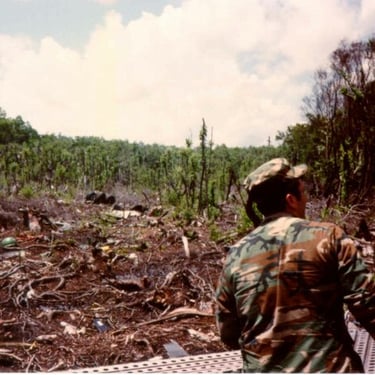
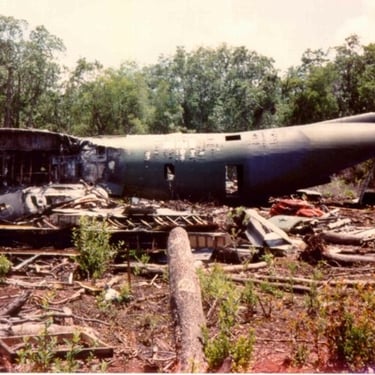
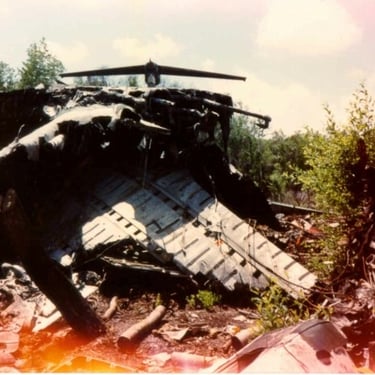
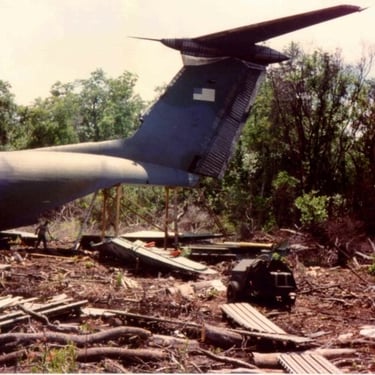
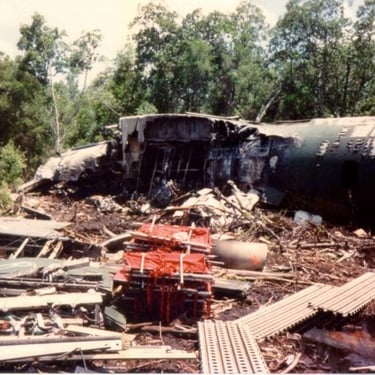
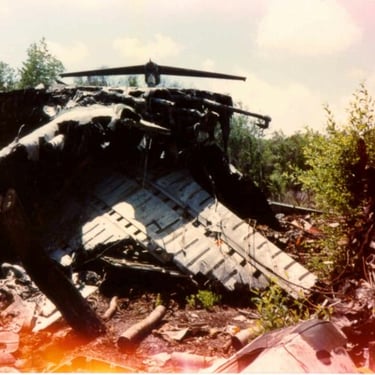
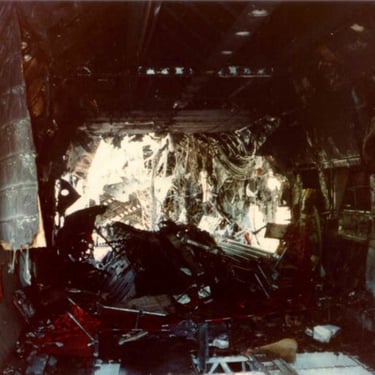
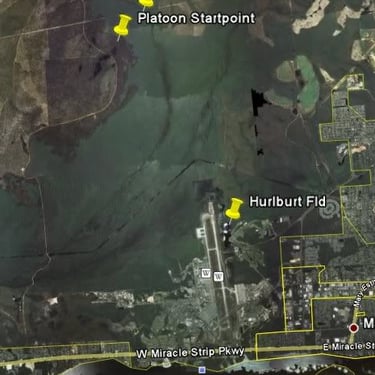

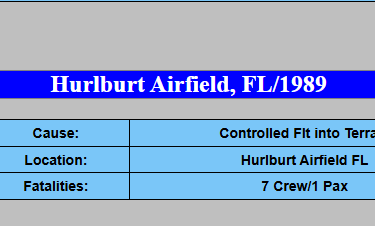
Courtesy of C141 Heaven
Synopsis: Following a long duty day, and to avoid severe weather, the crew elected to complete a non-precision approach. Inside the Final Approach Fix (FAF) the aircraft developed a high rate of descent. Despite GPWS warnings, the aircraft impacted in a wings level, nose low attitude more than four miles from the runway.
The crew had flown a long duty day. They had departed Norton AFB in the morning, but a leaking comfort pallet required a diversion back to Norton. After maintenance repaired the leaking pallet, they departed Norton AFB for Peterson AFB Colorado, then Hurlburt Airfield Florida . As they approached their destination, shortly after 2000hrs, thunderstorms covered the approach path for the ILS approach to runway 36, the primary instrument runway.
The crew requested the TACAN approach to runway 18. The approach course was over uninhabited swampy terrain, the classic "black hole" approach. After passing the FAF, the crew allowed the aircraft to enter a high rate of descent. The copilot reset two GPWS warnings. No verbal comments were made by any crew member about the high rate of descent or descending below the Minimum Descent Altitude (MDA) of 345' AGL.
They impacted the terrain
12 to 13 degree nose low
Wings level
Throttles at idle
Flaps Landing
Gear down:
Vertical velocity - descending 3000 to 4000 fmp
I have kept this incident to myself over the years, why, I’m not really sure. I guess it started with the investigators requests not to have any contact with the media or discuss the details of the crash with anyone else.
20 years ago, on this day, started out like any other winter day in February in Florida at Eglin. No swamp or boat movement this day, only a simple recon and raid mission. I had the PL, PSG and WSL grades, Nieves had the 3 sqd ldrs. Sometime that afternoon, the weather began to turn. Movement continued. At the security halt, it started to rain steady. I figured maybe the students would take advantage of it (sound masking sound) as they were beginning to fall behind their time schedule taking forever to establish their ORP.
Leaders recon finally moves out, pinpoints the obj, emplaces security etc. By now, the rain is really starting to come down-hard. I’m thinking, these guys better get their heads out of their ass and start picking up the pace. Hit time was 2030 hrs. The Ldrs recon made it back to the ORP around 1945 hrs. The remainder of the platoon is already situated to move out (support, assault etc) I’m telling the PSG he had better give the PL a hint to move with a purpose.
We finally start moving and for some reason, we already have a break that has to be fixed, slowing us down even further and then, a full blown electrical storm is right on top of us. I mean, this was a storm that was downright mean and nasty. Unusual for February, happens later on in the year, not now. I had the students halt, conferred with Nieves, gave them instructions and moved away from the formation for admin communication. I tried to make contact with PI with no success and finally made contact with the API Stevenson (1/75) to let him know I’m breaking down the long whips and any further comms needed to be routed through me or the PSG walker.
I then took a moment, leaning on my walking stick, looking at the formation, from front to rear, up against the swamp line, looking at my watch, getting more pissed as they’re moving like pond water just to accomplish one simple task.
All of a sudden, out of the NNE, I spot red and green lights, breaking through the ceiling (which I estimated to be about 300 feet or so) recognizing it as an A/C, but not seeing the outline of the rest to make out exactly what it was that was flying. I can’t hear the engines. My next thought was “Who in the hell is flying in this weather anyway?” Being north of Hurlbut AFB, maybe one of the SOS flyers is practicing approaches in suck ass conditions. Still can’t make out who or what it is. All I know is whomever it is, I can tell they have their hands full hanging onto it, watching the nav lights dipping up and down.
I’m still watching the angle of descent and start doing a mental reference where Hurlbut is, where we are and realize if he doesn’t change, he’s not going to make it. At this point, I’m no longer even thinking about the students as I begin talking and telling myself to have this guy pull up……pull up………pull up God damn it………..
And then I watch as the nav lights disappear behind the silhouette of the treeline. Then, it happens….first a fireball, then a roar…..and then one big explosion.
I yell at Nieves to have the Plt secure all of their shit, and move up to where I was standing. I then attempted to contact the PI (again) This time I make contact with him, inform him I was declaring a real world emergency and a aircraft had crashed NE of our location. His next transmission was “remain stationary and await further instructions.” While remaining “stationary” Nieves and I had the studs start dumping their rucks and bringing forth all the pyro in their possession, CLS kits, ponchos (for litters)
I then asked who in the platoon was a qualified medic. I still remember this guys name – Stalik was a 300 F1 medic, who came forward as did another 91 series. Meanwhile, I go back to make contact with the PI, several times, no answer. 10 minutes has passed and I’m thinking no one else is around or going to be available to help out anyone involved in that crash except us. I give Nieves instructions to break the platoon into 2 groups. I contact the opfor on the obj and tell them to yell into the woodline and get the remainder of the plt, get everyone and put everybody, including themselves onto the deuce and a half and meet me at a grid intersection 100 meters away from where I was standing.
I finally make contact with Stevenson on the Motorola letting him know what was going on and then asked him had he heard from 75? (The PI) He said no, not for several minutes. I tried again and was unable to raise him on the radio either. With that, I gave him a quick run down of what I was fixing to do and where I was going.
Myself, Nieves and the 3 OPFOR did a quick map recon. Nieves would take half the platoon on a north easterly azimuth into the swamp (which in this area of Eastbay never got more than a 2 feet deep) until he either found the crash site or came out onto the firebreak 800 meters in with the high tension wires that ran east to west as a limit of advance and would hold up there until we both linked back up with each other. We made a commo check and moved out.
I took the rest on the deuce, move to the firebreak, turn east and began to parallel the power lines along an unimproved road until we can’t move any further. I have everyone dismount, and we continue east. With the lightning now illuminating the backdrop, we move until I can see the silhouette of smoke coming out from the swamp/treeline into the open of the firebreak. We continue moving to Liveoak Creek. Once there, I turn, walk a few feet into the treeline along the creek and there it is. One huge stabilator sticking out of the swamp and then realize it’s a C-141. There’s the visual of all this, the fires around the A/C and the smell of burning flesh. I make contact with Nieves and ask for a sitrep. He lets me know he was about 100 meters out from it and can now see it from his location.
I tell the PL to start locating tree limbs for improvised litters. I attempt to contact Stevenson again with the radio and can’t make contact with him or anyone else. I have the RTO bring his radio up and attempt to do the same. All he can do is make contact with a sister platoon and relay info. As the swamp is mixed with jet fuel and not knowing what else, I take Stalik (the medic) and 3 other students with me to move up to the A/C. It appears the entire left wing and fuselage section from the wings on back are intact.
(**NOTE** In the pictures, the left wing is also missing. The pictures were taken later during recovery operations and the wing was removed)
The landing gear is detached. We move around and find the entire right wing is gone. The front of the A/C is obliterated. My concern at this point was to try and get inside the A/C in case anyone was seated toward the rear. The left troop door was jammed and the right troop door was not accessible. I moved forward, got up on Stalik’s back, and popped open the emergency hatch just forward of the troop door. I was able to make entry, yelling out for anyone to answer. As I looked inside, the smoke and fumes were choking the hell out me. All of the troop seats from the wing section on back were still intact. An Igloo cooler tied down with a CGU strap between both troop doors, was still intact without a scratch. I finally had to exit, realizing no one was in the rear.
Once out, I started walking around to the front and found the first victim with his leg sticking up out of the swamp water and vegetation. Nieves and his group were now linked up with us. I was then told a bunch of lights were coming at us from the east. I moved and had everyone else move back away from the A/C. The lights were that of some AF SP’s. They moved up and made contact. They wanted to come across Live Oak Creek. I got in the creek and told them to cross where I was standing. Do they listen to me? Nope. They want to cross without getting wet (even though they’re soaking wet already from the rain)
They move down to a fallen pine, climb on all 4’s across it. The first guy gets halfway across and I watch a 3000.00 secure comms Motorola drop into the creek. He says “Oh well, they’ll just write it off.” I’m thinking you just gotta love the AF.
When they finally get across, they begin telling me they received stories the A/C went down in the gulf (Of Mexico) another one that said it crashed into the fairgrounds and so many stories were floating around, no one knew where it was. I asked if he had another radio and contact with his higher, which he said he did. I told him to get the location back to his guys. He wanted a Long/ Lat fix. I told him I didn’t have long/lat, but told him to relay exactly as I called out a 6 digit grid coordinates, which he did.
We then established a makeshift CP and began to dry our comms out. Once dry, I was able to make contact with Stevenson. It wasn’t until around 2200-2215 that we began to hear a helo in the background. When they began getting closer, I shot a red star cluster up and waited to determine its course. I put 2 more in a row up and kept some in reserve along with my gyrojet.
When it finally got over us, it looked like it was our MEDEVAC 60 doing the flying. Colonel Oakes, the base commander from Eglin was on board. I was handed a radio from one of the SP’s, talked a minute or so with the Colonel, told him I was pretty sure no one survived. The A/C orbitted around for several minutes and then left saying they would be back.
The A/C returned at approximately 0030 hrs, hovered and began to lower rescue personnel and firefighters at our location. Moved around to the front of the A/C and found what was left of the pilot and co-pilot. Stayed on site until the am when LTC Keneally and COL Oakes arrived. Oakes asked Keneally for me to stay, which I did. I stayed until 12pm the next day and finally left after vectoring personnel and machinery in and out of the location.
I don’t remember the name of the AF Major in charge of the investigation, but in my final official statement in May when asked if there was anything further I wanted to add, it was to let the families know they were in all our thoughts and prayers. Army Rangers have always had a history of going in after downed pilots and always will. This was no exception.
There were 8 personnel onboard, 7 crew and one retired Captain.
God Bless all the family members who lost loved ones 20 years ago today.
Ranger Instructors on the ground with me that day:
D. Nieves (1/75)
J. Hislop (3/75)
B. Kolodetsky (3/75)
M. Healy (3/75)
RLTW,
CM
Army Rangers Account of the Crash
We welcome your feedback and any additional information you may have. Please share your thoughts through the registration form, and we will ensure that all comments—whether positive, negative, or neutral—are published.
Join us for the Norton reunion event.
© Norton Reunion 2025. All rights reserved.
